
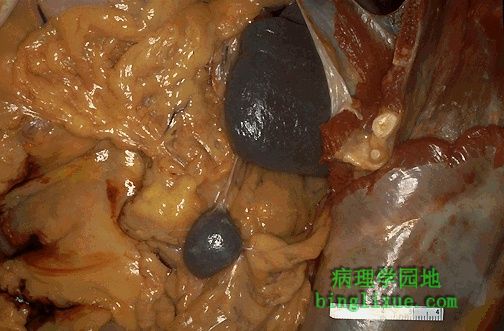 |
图示副脾,其实并不罕见。虽然,副脾不但有正常脾脏的表现,也可出现“脾组织种植”的情况,即当脾破裂时,部分脾(多由于外伤)种植在腹膜表面并发挥其功能。 Here is an example of an accessory spleen. These are not that uncommon and are really incidental findings. Remember, though, that the accessory spleen can undergo all changes that the larger spleen can. There is also a condition known as "splenosis" which occurs when portions of disrupted spleen (usually from trauma) implant on peritoneal surfaces and continue to function. |
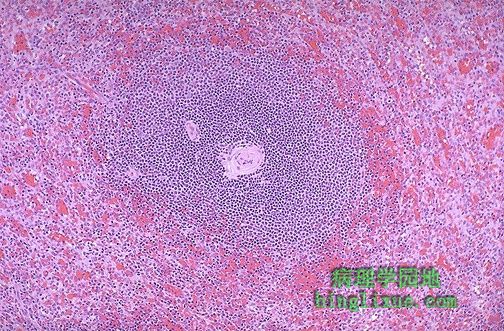 |
正常脾的组织学外观,可见小淋巴细胞围绕在中央的脾小动脉周围,形成白髓。周围是红髓构成许多脾血窦。脾具有过滤作用,清除衰老的红细胞和红细胞内含物,脾也是血小板的贮存库。 This is the normal histologic appearance of the spleen. Note the small lymphocytes centered around the splenic arteriole at the center, forming the white pulp. Around this is the red pulp comprised of many splenic sinusoids. The spleen acts as a filter, removing old red blood cells and RBC inclusions. The spleen also acts as a storage area for platelets. |
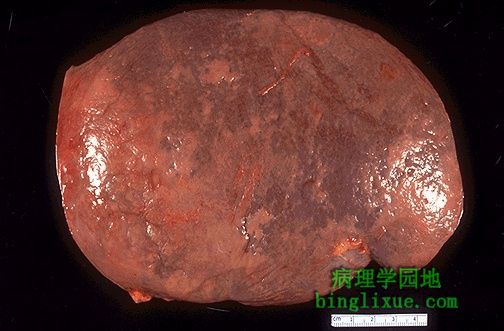 |
脾肿大常见原因之一是肝硬化门静脉高压。在美国,慢性酒精中毒引起的小结节型肝硬化比乙型或丙型肝炎引起的小结节型肝硬化更常见。图示脾的紫色表面上也显示有不规则的苍白色纤维性斑片,称为玻璃样脾周围炎。 One of the most common causes for splenomegaly is portal hypertension with cirrhosis of the liver. Micronodular cirrhosis from chronic alcoholism is more common in the U.S. than macronodular cirrhosis following hepatitis B or C infection. Note that this spleen also shows irregular tan-white fibrous plaques over the purple surface. This "sugar icing" has the name hyaline perisplenitis. |
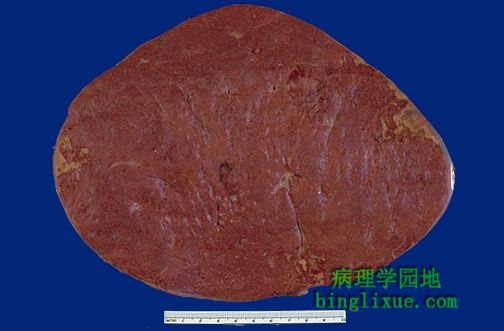 |
明显增大的脾(标尺显示有15厘米长)。这样的脾肿大通常预示有骨髓增生型疾病,例如慢性髓性白血病或骨髓纤维化。包膜下可见黄褐色梗死灶。淤血性脾肿大(肝硬化门脉高压的表现)不可能800克。脾大于1000克暗示有骨髓增生、淋巴组织增生或造血系统病变。 This is a markedly enlarged spleen (the ruler is 15 cm long). Such massive splenomegaly is usually indicative of some myeloproliferative disease such as chronic myelogenous leukemia or myelofibrosis. There are subcapsular yellow-tan infarcts. Congestive splenomegaly (as with portal hypertension in cirrhosis of the liver) is unlikely to increase the size of the spleen over 800 gm. A spleen >1000 gm suggests a myeloproliferative, lymphoproliferative, or hematopoietic disorder. |
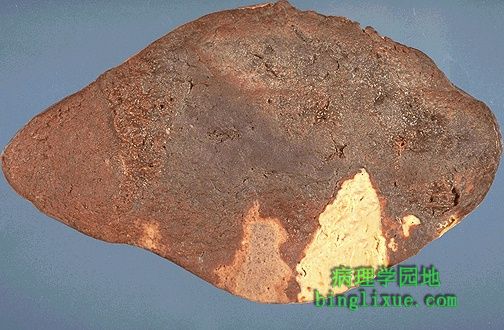 |
感染性心内膜炎病人脾梗死 ,部分赘生物脱落栓塞于脾导致脾梗死,梗死灶是典型的局部缺血性病变:基底部位于被膜、灰白色、呈楔型。 Here are splenic infarcts in a patient with infective endocarditis. Portions of the vegetations have embolized to the spleen. These infarcts are typical of ischemic infarcts: they are based on the capsule, pale, and wedge-shaped. |